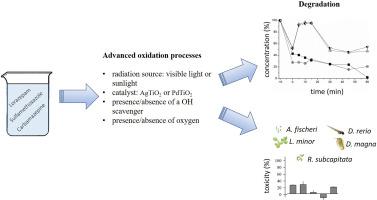Journal of Water Process Engineering ( IF 6.3 ) Pub Date : 2021-07-13 , DOI: 10.1016/j.jwpe.2021.102204 João Gomes 1 , Fátima Jesus 2 , Eva Domingues 1 , Fernando Gonçalves 2 , Joana Luísa Pereira 2 , Rui C. Martins 1

|
Pharmaceutical and personal care products are released in watercourses due to the inefficiency of conventional wastewater treatment and photocatalytic oxidation has been pointed out as an alternative. Thus, this study aimed at gaining an insight on the mechanism of reaction using different radiation sources (solar and visible) and catalysts (Ag-TiO2 and Pd-TiO2) for the abatement of a mixture of pharmaceutical contaminants of emerging concern (CEC) – Sulfamethoxazole (SMX), Carbamazepine (CBZ) and Lorazepam (LRZ). Moreover, aiming to evaluate the effectiveness of these treatments to improve their environmental friendliness, an ecotoxicological evaluation was carried out by assessing the responses of several indicator organisms (fish, cladocerans, plants, microalgae and bacteria). The hydroxyl radical had a major role on photocatalytic oxidation. 90% of CBZ degradation was achieved after 60 min using sunlight and Ag-TiO2 whereas this removal was reduced to 15% with hydroxyl radical scavengers. Concerning the ecotoxicological evaluation, the untreated mixture was mildly toxic to these organisms (approximately 30% depression in the assessed endpoints), except for microalgae, where a pronounced toxicity (85% of growth inhibition). Treated solutions achieving lower concentrations of the parent compounds, were generally found to be more toxic than the untreated mixture. For example, after solar photocatalytic oxidation using Ag-TiO2 the toxicity of the mixture to the microalgae and Daphnia magna increased or remained unaffected. This suggests the formation of toxic by-products during the treatments, highlighting that effective treatments do not always translate into improved environmental friendliness. These results raise concern on the environmental safety of the water treatment technologies.
中文翻译:

使用阳光和可见辐射光催化氧化新出现的药物污染物:机制和生态毒理学评价
由于传统废水处理和光催化氧化效率低下,药物和个人护理产品会在水道中释放出来。因此,本研究旨在深入了解使用不同辐射源(太阳能和可见光)和催化剂(Ag-TiO 2和 Pd-TiO 2) 用于减少新出现的药物污染物 (CEC) – 磺胺甲恶唑 (SMX)、卡马西平 (CBZ) 和劳拉西泮 (LRZ) 的混合物。此外,为了评估这些处理对改善环境友好性的有效性,通过评估几种指示生物(鱼类、枝角类动物、植物、微藻和细菌)的反应进行了生态毒理学评估。羟基自由基在光催化氧化中起主要作用。使用阳光和 Ag-TiO 2 60 分钟后实现了 90% 的 CBZ 降解而使用羟基自由基清除剂将这种去除减少到 15%。关于生态毒理学评估,未经处理的混合物对这些生物有轻微毒性(在评估的终点中大约有 30% 的抑制),但微藻除外,微藻具有明显的毒性(85% 的生长抑制)。发现母体化合物浓度较低的处理溶液比未处理的混合物毒性更大。例如,在使用 Ag-TiO 2进行太阳能光催化氧化后,混合物对微藻和大型水蚤的毒性增加或不受影响。这表明在处理过程中会形成有毒副产物,突出表明有效的处理并不总能转化为环境友好性的改善。这些结果引起了人们对水处理技术的环境安全性的关注。











































 京公网安备 11010802027423号
京公网安备 11010802027423号